Monthly Archives: December 2011
Hakutsuru Nishiki on the Gold Coast?
Australia’s sake market is still very much in infancy compared to America, Europe and of course Japan. There are many amazing brands of sake out there that haven’t made it to these shores yet. So when something a little on the rare side comes our way it’s pretty exciting.
Renowned sake guru John Gauntner has recently been reporting on the unusual Hakutsuru-nishiki strain of rice that is being grown on the rooftops of sake behemoth Hakutsuru’s Ginza offices. Hakutsuru-nishiki is a cross-breed of Yamadaho and Wataribune rice. Interestingly, these are the same parent rices for the almighty Yamada-nishiki, widely regarded as the best of all sake rice.
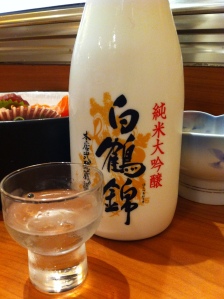 Hakutsuru (the world’s largest sake brewery) developed Hakutsuru-nishiki and have been growing it in their home prefecture of Hyogo as well as their other rather unusual location in fairly small quantities since 2004. I’d found John’s reports on this sake rice quite interesting so I was excited to find out that local Japanese restaurant Donto Sapporo had procured six bottles of Hakutsuru’s Hakutsuru Nishiki Junmai Daiginjo. Considering it is fairly hard to come by in Japan, to have some available here on the Gold Coast seemed like quite a coup.
Hakutsuru (the world’s largest sake brewery) developed Hakutsuru-nishiki and have been growing it in their home prefecture of Hyogo as well as their other rather unusual location in fairly small quantities since 2004. I’d found John’s reports on this sake rice quite interesting so I was excited to find out that local Japanese restaurant Donto Sapporo had procured six bottles of Hakutsuru’s Hakutsuru Nishiki Junmai Daiginjo. Considering it is fairly hard to come by in Japan, to have some available here on the Gold Coast seemed like quite a coup.
Donto Sapporo is one of the Gold Coast’s older Japanese restaurants (est. 1990) and has 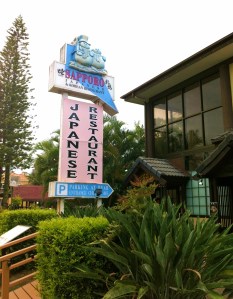 built a reputation on being one of the top spots for quality sushi, sashimi and traditional Japanese cuisine. In an area where cheap and cheerful Japanese restaurants tend to rule, Donto shows some old school class.
built a reputation on being one of the top spots for quality sushi, sashimi and traditional Japanese cuisine. In an area where cheap and cheerful Japanese restaurants tend to rule, Donto shows some old school class.
Naturally then, the order of the day was sashimi and a bottle of Hakutsuru Nishiki Junmai Daiginjo. As a side note, there is a small contingent of extreme traditionalists out there who insist sashimi should not be had with sake and that only tea (preferably green) should be consumed with quality sushi and sashimi. Absolute rubbish in my opinion. Sake and sashimi is one of life’s true hedonistic pleasures never to be missed when the opportunity presents itself. Sorry for the digression….
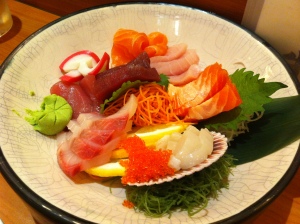 Unsurprisingly given its pedigree, the Hakutsuru-nishiki shows remarkable similarity to Yamada-nishiki; A beautifully elegant nose of white flowers with the tiniest hint of aniseed rather than fruit. Balance was impeccable with a nice, medium weight, soft acidity and an extraordinarily long finish. Like many Daiginjos it’s quite a showy style of sake and definitely one for savouring rather than just casual drinking.
Unsurprisingly given its pedigree, the Hakutsuru-nishiki shows remarkable similarity to Yamada-nishiki; A beautifully elegant nose of white flowers with the tiniest hint of aniseed rather than fruit. Balance was impeccable with a nice, medium weight, soft acidity and an extraordinarily long finish. Like many Daiginjos it’s quite a showy style of sake and definitely one for savouring rather than just casual drinking.
Unless you’re here on the Gold Coast you may find this sake a little hard to come by but hopefully it’s a sign that Australia is starting to be recognised as a potentially serious market by breweries and we can look forward to some more gems coming our way.
Kozaemon Masterclass
Thursday night I was lucky enough to 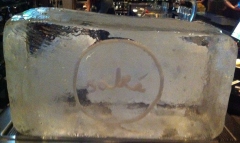 attend a sake tasting/masterclass at Sake Restaurant in Brisbane. An event organised by Sommeliers Australia, it was great to see such a strong interest in sake from folks normally nose deep in wine. One of the things I love about these kind of events is the opportunity to try different styles and grades of sake alongside each other so the differences are even more apparent. And I think some of the sommeliers in attendance were pleasantly surprised at the range and diversity sake can display. On show for the evening was sake from Nakashima Brewing’s Kozaemon.
attend a sake tasting/masterclass at Sake Restaurant in Brisbane. An event organised by Sommeliers Australia, it was great to see such a strong interest in sake from folks normally nose deep in wine. One of the things I love about these kind of events is the opportunity to try different styles and grades of sake alongside each other so the differences are even more apparent. And I think some of the sommeliers in attendance were pleasantly surprised at the range and diversity sake can display. On show for the evening was sake from Nakashima Brewing’s Kozaemon.
Nakashima is located in Gifu prefecture in central Japan. A fairly sleepy kind of area probably best known for its snow fields in winter. Boasting a 300 year history of sake making, Nakashima prides itself on their commitment to maintaining close relationships with all their contacts, in particular the growers of their rice.
The evening was hosted by Sake Restaurant sommelier and resident sake expert Miriam McLachlan along with Nakashima Brewing president Kozaemon-san himself 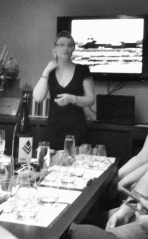 who happened to be in town. After running through some sake basics, presented in a detailed slide show and a look at some rice samples milled to different sizes it was down to the business of tasting We had seven different sakes representing a good diversity of styles from Kozaemon’s portfolio.
who happened to be in town. After running through some sake basics, presented in a detailed slide show and a look at some rice samples milled to different sizes it was down to the business of tasting We had seven different sakes representing a good diversity of styles from Kozaemon’s portfolio.
First up was the Honjozo Kyoukai #7 Koubo Seimaibuai 70%- The seven refers to the number yeast used (sake yeasts are rather boringly numbered rather than having any names that refer to the type of flavour or aromas of the yeast). In true honjozo style there were some lifted aromatics with floral hints and aniseed notes. Not an overpowering or attention-demanding sake, more suited to everyday drinking and probably best served chilled (as the restaurant does) rather than warming.
It was great to try the junmai next as it accurately highlighted how much honjozos and 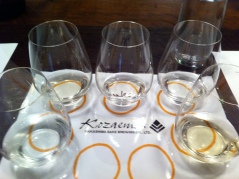 junmai can differ when done conforming to typical style profiles. The junmai was rustic, earthy with peppery grip and nice full umami richness. The fact that it had a milling rate of only 80% (as opposed to the more common 70% or thereabouts) further highlighted the ricey, chewy characteristics junmai can sometimes have.
junmai can differ when done conforming to typical style profiles. The junmai was rustic, earthy with peppery grip and nice full umami richness. The fact that it had a milling rate of only 80% (as opposed to the more common 70% or thereabouts) further highlighted the ricey, chewy characteristics junmai can sometimes have.
Next up was the Junmai Ginjo Shinano Miyamanishiki Organic (seimaibuai 50%). This proved to be the favourite among most of the crowd myself included. Beautiful banana, bubblegum and soft stone fruit aromas lead to a well-balanced palate with fresh acidity and satisfying fullness. You may notice that this sake has a seimaibuai of 50% which by rights would enable the brewers to label it the higher grade of Daiginjo. However as Kozaemon-san explained, it isn’t about claiming a certain classification just because you can. This particular sake was designed as a junmai ginjo and fits that flavour profile. The brewer will label the sake as he/she sees fit. If the sake is not a daiginjo in their eyes they will not label it as such even though they could and charge a higher price accordingly.
Quite noble and honest.
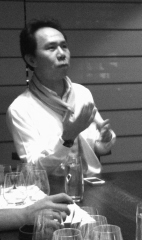 Speaking of daiginjos next up was the Kozaemon Junmai Daiginjo (50%) which I believe cemented Kozaemon-san’s words about labelling sake as appropriate to style. In daiginjo fashion, the elegant, floral perfumed notes jumped out the glass. Managing to be light yet still showing some body, this is a very good daiginjo.
Speaking of daiginjos next up was the Kozaemon Junmai Daiginjo (50%) which I believe cemented Kozaemon-san’s words about labelling sake as appropriate to style. In daiginjo fashion, the elegant, floral perfumed notes jumped out the glass. Managing to be light yet still showing some body, this is a very good daiginjo.
A 3yr old Junmai Koshu was next. Unsurprisingly many of the sommeliers in attendance were keen to know about the effects of ageing sake and whether it was possible. Golden in colour, musty, cheesy aromas mixed with notes of old wood and hints of sherry. Definitely showing the possible outcome of ageing sake it was a fairly textbook example of koshu. It certainly aroused interest.
Kozaemon Tokubetsu Jikagumi was an interesting spin on namazake (unpasteurized sake). Jikagumi means “directly pumped out” or perhaps “straight from the source” would be a better translation. Basically it is sake that is bottled straight after pressing rather than being fine filtered and pasteurized so it actually contains some of the naturally occurring CO2 from the fermentation process which gives it a very slight spritz. Essentially nama in style; it showed plenty of over the top aromas of melon, some tropical fruit and a background of strawberries and cream lollies. A fun sake.
The tasting was topped off with a look at their Yuzu infused sake. Yuzu being a tart Japanese citrus fruit. Almost like a limoncello, it makes a nice digestif.
Overall, it was a great evening. Kozaemon-san was a most affable and approachable host and Miriam is as passionate as she is knowledgable. Sake Restaurant itself is a very cool venue with a nice mix of Japanese tradition and modern class both in decor and food. Kozaemon sake is exclusive to the two Sake Restaurants (other one is in Sydney) and cannot be found in any bottle shops. So, if you’re up for some quality sake and fusion Japanese food served by knowledgable staff – you now know where to go.
P.S. Apologies for the quality of the photos, I was far too engrossed in the sake.
Hitachino Nest Red Rice Ale
It’s always good to get beyond the boring old pale lagers that most folks drink and find beers that can really challenge people’s perception of what beer is. No doubt when most people think of Japanese beer they think of Asahi, Kirin and probably Sapporo. Sadly though, the versions of these beers sitting in your local bottleshop are not even made in Japan. Asahi is brewed in Thailand, Kirin is brewed by Lion Nathan and Sapporo is now brewed under license by Coopers. The exception being you can sometimes find the real versions of these on tap in some Japanese restaurants.
But come on peeps, let’s think outside the box! For something that really screams “Japan!”, you can’t go past Hitachino Nest. Hitachino Nest is the beer label for Kiuchi Sake Brewery from Ibaraki prefecture located a little south of the main areas hit by the tragic earthquake that hit March earlier this year. (There are some amazing pictures of the damage to the brewery and the neighbourhood on their website). A brewery that makes sake, shochu and beer; these guys have their hands full. Taking the wonderful approach of using local ingredients and traditional methods to create something with a true Japanese character, the Red Rice Ale is a great place to get your preconceptions of Japanese beer turned on their head.
You may or may not have seen red rice before; usually used in ceremonial dishes, it is rice fermented with a red mould giving it its colour. This rice is added to the beer 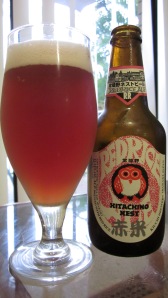 mash which then spends some time in sake casks – really bringing out a flavour unlike any other beer. Oddly, one of the initial aromas that jumps out is that of black olives but it makes way for some cherry, strawberry and hints of sake phenols with very mild bitterness. And the 7% alcohol is very well hidden.
mash which then spends some time in sake casks – really bringing out a flavour unlike any other beer. Oddly, one of the initial aromas that jumps out is that of black olives but it makes way for some cherry, strawberry and hints of sake phenols with very mild bitterness. And the 7% alcohol is very well hidden.
Not really a beer for sushi or fish dishes, I think you’ll find the Red Rice Ale goes quite well with pickled vegetables and tsukemono. So, next time you’re looking for some real Japanese beer remember there is more out there than just crisp dry lagers.